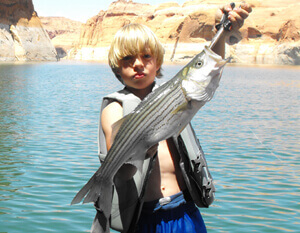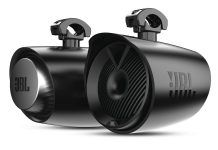Lake Powell Stripers
Enjoy Bass Fishing, Trolling At Cool Lake Powell

ANCHOVIES GET AN “A” — 10-year-old Austin Macosky, from Phoenix, Ariz., holds a striper caught in Lake Powell’s Navajo Canyon. Trolling has been good, but this fish was caught on anchovy bait, the normal springtime standard striper bait.
Did it rain at your house? Early June has been more like a nice week in April than June in the desert. Normally, air temperature is nearing the century mark here, but we will take the 70s for now and enjoy the heat when it comes.
Fishing conditions have not changed much since last report. Water still runs in at a rate of 80,000 acre-feet per day. Lake level still increases by 3-6 inches. Surface temperature is holding near 70 degrees. Bass are still biting and stripers randomly boil.
Best fishing is for smallmouth along the main channel and main canyon areas. Steep, slick rock and cliff face areas seem to hold more agreeable fish than other spots.
Look for a bit of broken rock, a ledge or terrace that provides just a tiny bit of cover in the vast expanse of clean, slick rock. Find a bush in a crack or fracture of the slick rock, and a largemouth may lurk there as well.
Bass are looking for crayfish and are willing to hit plastic near bottom in the 20-30-foot range. Our tendency is to fish the shoreline from a boat, holding about a cast or two off shore. The better thing to do now is put the boat in the same location but drop the lure straight to the bottom instead of casting toward shore. Once the lure contacts bottom, let it drift slowly along the 25-foot contour. Gently ease the bait along the bottom to encounter bass and walleye.
Early in the morning, shad are spawning farther back in the canyons and coves on the surface around brush and driftwood. Shallow-running crankbaits and top-water lures work well at first light before the sun hits the water.
The extended spring weather means that a variety of species is working on vulnerable shad. It is possible to catch bass, stripers, walleye, catfish, and sunfish near the site of any spawning shad school. Shad spawning activity subsides by 8 a.m., and game fish move to their daily holding pattern. Bass go deep; stripers cruise the shoreline along that same 25-foot contour.
Trolling the 25-foot flats is effective but not fast fishing. Rattle-trap baits are effective for both bass and stripers. Shallow-running crankbaits, like glass shad raps and lucky craft bevy shad, also work well. It seems to me that shorter baits (3 inches) are more effective than longer ones (Thundersticks). Look out for treetops that grab trolling lures but get close enough to brush to attract fish interest. A lure that runs right over the brushy treetops is a great choice.
While doing all this, keep an eye out for random striper boils. I get new reports every day of random boils occurring mid-morning over the expanse of the lake.
Boils are becoming more visible and staying up longer. Unfortunately, they are not yet predictable or repeatable occurrences.
But, top-water time is getting closer. Expect stripers to become catchable in boils as the lake stabilizes and water temperature warms. Shad will grow faster in warmer waters and hasten the boil response. Until then, enjoy bass fishing and trolling in the cool springtime luxury of Lake Powell. At press time, lake elevation was 3,633, and water temperature: 70-74F.































